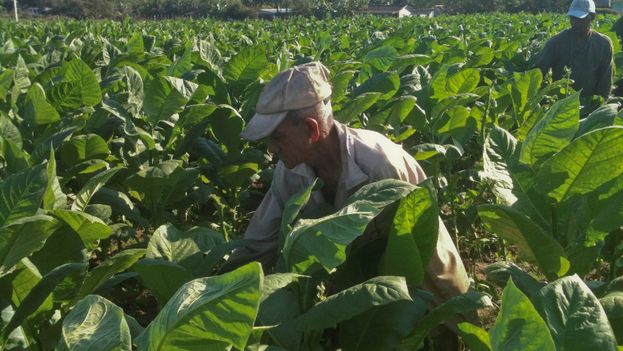
![]() 14ymedio, Juan Carlos Fernandez, Pinar del Rio, 9 February 2016 – The sun has barely risen and boots are sinking into land that is pure mud. In the furrows, a group of men is trying to revive the planted tobacco, but nature is working against them. Hundreds of producers in Pinar del Rio are struggling against the rain and the pests to save a tobacco crop which promises to be among the lowest in decades.
14ymedio, Juan Carlos Fernandez, Pinar del Rio, 9 February 2016 – The sun has barely risen and boots are sinking into land that is pure mud. In the furrows, a group of men is trying to revive the planted tobacco, but nature is working against them. Hundreds of producers in Pinar del Rio are struggling against the rain and the pests to save a tobacco crop which promises to be among the lowest in decades.
Prior to 20 January, 42,000 acres of land were planted throughout the province of Pinar del Rio, but only some 34,000 have managed to survive, and of these, some 5,000 are seriously affected. The excess moisture has also encouraged the emergence of the dreaded blue mold disease that devastates the crop.
A descendant from immigrants who came from the Canary Islands, Justo Garcia Hernandez hasn’t quit working, even at 73. He moves between the plantations and the tobacco house where the women of the family are busy hanging the leaves. In the five acres this farmer has leased under usufruct, he experiences the failed harvest with special intensity.
This year “the climate is a disaster,” complains Justo. The continuous rains in recent weeks have ruined countless fields like his. “The current weather conditions favor the appearance of fungi, bacteria, viruses and other diseases,” declared the provincial director of Plant Protection, Ariel Castillo Rodriguez.
The land that Justo and his family work belongs to the Carlos Hidalgo Credit and Services Cooperative, at Kilometer 5 on the San Juan Highway. The space allows him to plant up to 80,000 tobacco plants, but this year many of the plants will have died “having barely emerged from the ground,” says the farmer.
Still, he says he feels fortunate because his land “has not been affected by black shank or blue mold,” thanks to his having fumigated. The situation has been most difficult for the farmers in Vueltabajo region of Pinar del Rio, particularly in the towns of Consolación del Sur, Pinar del Río, San Juan y Martínez and San Luis.
The problems started right at the beginning of the harvest. Virginio Morales, acting director of the Provincial Tobacco Group, reported to the local press last week that the combination of high temperatures and the excessive rainfall associated with the El Niño phenomenon, has caused the loss of “83,500 seedling beds, and another 27,000 have been affected.”

The constant rains have greatly affected Justo’s plantings. “It’s the greatest damage my harvest has had, the tobacco is drunk, the plants remain tiny, it doesn’t grow because of the excessive rain.” More than 40% of the harvest has been lost for this reason and the only solution is “replant, even though it is not the season.”
The optimum time for planting is already over, but hundreds of producers are going to plant tobacco, even to the end of March, to make up for the damage the rain has caused to the crop. The bad news is that it is still raining and the new shoots are also starting to be damaged.
The downpours “leave the leaves without their natural fatness,” comments Justo, a man who has lived his whole life around the tobacco fields. As an example, he tells how he has harvested tobacco from very early in the morning, and “it’s four in the afternoon and I have clean hands, if the tobacco was good, I would have had to wash my hands ten times.”
Justo, like many tobacco growers in the area, does not believe that the crop insurance will repay for what was damaged. Last year he lost 16,000 plantings and they only paid him 2,200 Cuban pesos (less than $100 US).
In the Hoyo de Monterrey in San Juan y Martinez, a place where many say the best tobacco in the world is grown, Luis Brito Ajete concludes, “The tobacco is bad.” In the five acres he cultivates with his son, “the plants have leaves like tissue paper,” he complains.
The same thing is happening in Rio Feo, in the town of San Luis. William Delgado Rodriguez plants tobacco on 7 acres and, although he says he’s had a “good harvest” in other years, this one “is bad, bad.” On his land he planted 100,000 sets. “But between the water and the black shank disease, it’s making me crazy.”
To demonstrate the situation, William pulls up a fragile-looking plant and shows the damage caused by the disease on the lower stem. In the area where his farm is nestled, in the Ormani Arenado Cooperative, the plantings have stood up a little better, but in other areas “the farmers have had to pull up the entire harvest for replanting.”
The young man noted that, right now, he has very little tobacco in the drying house and knows cases of other peasants whose tobacco has rotted after harvesting because of the dampness, so he is not expecting big profits from the current harvest. “For a 220 pounds, we are paid 1,950 Cuban pesos, and the quality of the leaf here will be very low,” he predicts.
From a small battery-powered radio comes the contagious rhythm of Bob Marley singing “No Woman No Cry” and the farmer takes advantage of it to say, “well, this is the harvest of tears.”
